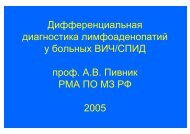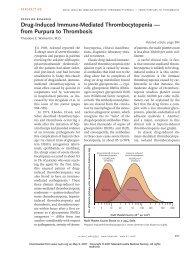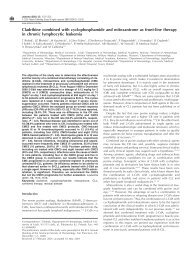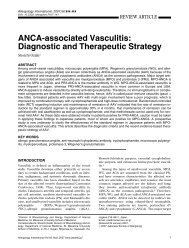Multicentric Castleman's Disease - HEM-AIDS
Multicentric Castleman's Disease - HEM-AIDS
Multicentric Castleman's Disease - HEM-AIDS
Create successful ePaper yourself
Turn your PDF publications into a flip-book with our unique Google optimized e-Paper software.
Castleman <strong>Disease</strong>:<br />
The Role of Viral Infections<br />
Corey Casper, MD, MPH<br />
Department of Medicine, Division of Infectious <strong>Disease</strong>,<br />
University of Washington<br />
Program in Infectious <strong>Disease</strong>s,<br />
Fred Hutchinson Cancer Research Center
CD and HIV<br />
o HIV-infected patients frequently experience<br />
enlarged lymph nodes, which may be due to a<br />
wide variety of diseases<br />
‣ Many patients never have etiology definitively established<br />
o In some cases, enlarged lymph nodes are due to<br />
CD<br />
‣ HIV patients with CD almost always have the M-PCV variant<br />
♦ Oksenhendler E, et. al. Aids 1996; 10:61-7.<br />
o No relationship between CD4 count and onset of<br />
symptoms<br />
o Role of HIV therapy therapy unclear<br />
‣ Early reports of severe flares of MCD with the initiation of<br />
HIV therapy were not corroborated by subsequent studies<br />
♦ Zietz C, et. al. N Engl J Med 1999; 340:1923-4.<br />
o Extremely increased risk of progression to<br />
aggressive non-Hodgkin’s lymphoma<br />
‣ 25% risk over 2 years found in the largest series<br />
♦ Oksenhendler E, et al. Blood 2002; 99:2331-6.
CD – A Viral Cause?<br />
o The symptoms seen in the first patients<br />
described to have CD led many to<br />
suspect viral etiology<br />
o The human gamma-herpesviruses,<br />
Epstein-Barr Virus (EBV) and Human<br />
Herpesvirus 8 are both viral oncogens<br />
(viruses which can cause cancer),<br />
making them prime candidates for a<br />
role in the development of CD
The Herpesvirus Family<br />
o HHV-1 : HSV-1<br />
‣ Clinical: Oral Herpes<br />
o HHV-2 : HSV-2<br />
‣ Clinical: Genital Herpes<br />
o HHV-3 : VZV<br />
‣ Clinical: Chickenpox<br />
o HHV-4 : EBV<br />
‣ Clinical: Mono, lymphoma<br />
o HHV-5: CMV<br />
‣ Clinical: Retinitis<br />
o HHV-6/7: Roseolovirus<br />
‣ Clinical: Exanthem subitum<br />
o HHV-8: KSHV
EBV and CD<br />
o Some of the cells observed in biopsy tissue<br />
from lymph nodes of patients with CD look<br />
similar to cells infected with EBV<br />
o Efforts to associate EBV with CD are<br />
challenging<br />
‣ >90% of US population has been infected with<br />
EBV<br />
‣ EBV often can reside in lymph nodes of healthy<br />
people for their entire life, so detecting EBV in<br />
lymph nodes of patients with MCD is not proof of<br />
causality<br />
o Currently, it is thought that there is no role for<br />
EBV infection in CD
HHV-8 and CD<br />
o Early series of patients with CD<br />
recognized an increased prevalence<br />
of Kaposi Sarcoma (KS)<br />
o In 1994, human herpesvirus 8 was<br />
found to be the infectious agent<br />
responsible for KS<br />
‣Member of the gamma-herpesvirus<br />
family, whose only other member<br />
infecting humans is EBV
HHV-8 Clinical Syndromes<br />
o Kaposi’s Sarcoma<br />
o Body Cavity Based Lymphoma<br />
o <strong>Multicentric</strong> Castleman’s <strong>Disease</strong><br />
o Idiopathic Pulmonary Hypertension?<br />
o Prostate Cancer?<br />
o Multiple myeloma<br />
o Sarcoid
Global HHV-8 Infection
HHV-8: Epidemiology<br />
o Prevalence in the population varies<br />
by geography and demographic<br />
group<br />
‣ Men who have sex with men in the US<br />
and Europe: 25-30% of<br />
immunocompetent men and 55-75% of<br />
men infected with HIV<br />
‣ Geography: Seroprevalence among<br />
healthy adults in Southern Europe, Africa,<br />
the Middle East between 30-100%<br />
o Unclear how virus is transmitted<br />
‣ Frequently found in saliva<br />
‣ Epidemiologic studies find that infection is<br />
correlated with sexual behavior in the US<br />
but the infection is usually acquired in<br />
childhood in Africa and the Middle East
Are All CD Patients Infected with HHV-8?<br />
o No comprehensive study to document<br />
proportion of CD patients infected with HHV-8<br />
‣ Small studies suggest between 30-100%?<br />
Study HIV Status CD Variant Proportion<br />
HHV-8 Infected<br />
Soulier, et. al. (1995) Negative<br />
M-HVV 2/3 (66%)<br />
M-PCV 3/9 (33%)<br />
M-Mixed 2/5 (40%)<br />
TOTAL 7/17 (41%)<br />
Positive<br />
M-HVV 1/1 (100%)<br />
M-PCV 6/6 (100%)<br />
M-Mixed 7/7 (100%)<br />
TOTAL 14/14 (100%)<br />
Kikuta, et. al. (1997) Negative<br />
M-PCV 2/2 (100%)<br />
U-HVV 1/1 (100%)<br />
Suda, et. al. (2001) Negative M-Unspecified 0/79 (0%)<br />
Positive<br />
3/3 (100%)<br />
Yamasaki, et. al. (2003) Negative M-PCV 13/16 (81%)<br />
Soulier J, et al. Blood 1995; 86:1276-80.<br />
Suda T, et al. Pathol Int 2001; 51:671-9.<br />
Yamasaki S, et al. Br J Haematol 2003; 120:471-7<br />
Kikuta H, et al. Br J Haematol 1997; 99:790-3.
HHV-8 and CD: Evidence for Causality<br />
o In most other diseases associated with HHV-<br />
8, the virus can rarely be found in blood<br />
‣ In KS, HHV-8 is found in skin tumor or in saliva, but<br />
not in blood<br />
o CD flares, however, are accompanied by<br />
dramatic rises in plasma HHV-8 levels, which<br />
decline with resolution of symptoms<br />
o Treatment of CD with antiviral medications<br />
may result in resolution of symptoms
HHV-8 and IL-6<br />
o HHV-8 encodes a gene which is a viral<br />
interleukin 6 (vIL-6) analogue which is<br />
transcribed actively during lytic<br />
infection<br />
‣50% similarity to hIL-6 on amino acid level<br />
o vIL-6 complexes to the IL-6 binding<br />
protein, IL-6Rα, and binds the hIL-6<br />
receptor, gp130<br />
♦ Aoki Y, et al. J Hematother Stem Cell Res 2000; 9:137-45.<br />
o Expression of vIL-6 also stimulates hIL-6
HHV-8 and IL-6 (continued)<br />
HHV-8 Infected B-Cell<br />
vIL-6<br />
IL-6R<br />
gp130<br />
JAK/STAT3<br />
STAT-responsive transcription<br />
of VEGF in nucleus<br />
Fibroblast,<br />
Endothelial<br />
Cell or<br />
Lymphocyte<br />
IL-6 leads to stimulation enumeration and<br />
stimulation of plasma cells to cause<br />
increased immunoglobulins,<br />
plasmocytomas or enlarged lymph nodes<br />
VEGF leads to<br />
angiogenesis and<br />
endothelial cell<br />
proliferation
Unified Model of CD Pathogenesis<br />
Antivirals<br />
HHV-8 Infection<br />
Lymphocyte<br />
Proliferation<br />
IL-6 Gene Promoter<br />
Polymorphisms<br />
Increased IL-6 Production<br />
Organomegaly<br />
Alteration of IL-6<br />
Cell Signaling<br />
Pathway<br />
Monoclonal Anti-<br />
IL-6 Antibody<br />
Capillary Leak<br />
Rituximab<br />
& / or<br />
Chemotherapy<br />
Lymphoma<br />
Ig Dysregulation<br />
Pulmonary<br />
Edema<br />
Renal<br />
Insufficiency<br />
Sepsis<br />
POEMS
Antiviral Therapy and HHV8<br />
o In vitro studies<br />
‣ Many antiherpetic antivirals have efficacy against HHV-8 in<br />
a test tube<br />
• Cidofovir > ganciclovir> foscarnet > famciclovir > aciclovir<br />
• Neyts J, De Clercq E. Antimicrob Agents Chemother 1997;41(12):2754-6.<br />
• Medveczky MM, et al. Aids 1997;11(11):1327-32.<br />
• Kedes DH, Ganem D. J Clin Invest 1997;99(9):2082-6.<br />
o Observational Studies<br />
‣ <strong>AIDS</strong> patients with CMV retinitis receiving ganciclovir had a<br />
40% reduction in odds of developing KS<br />
• Mocroft A, et al. Aids 1996; 10:1101-5.<br />
• Martin DF, et al. N Engl J Med 1999; 340:1063-70.<br />
o Clinical Studies<br />
‣ Cidofovir was ineffective in treating HIV-associated KS<br />
• Little RF, et al. J Infect Dis 2003; 187:149-53.<br />
‣ Both valganciclovir and ganciclovir was effective in<br />
reducing HHV-8 viremia and inducing a complete<br />
remission of <strong>Multicentric</strong> Castleman <strong>Disease</strong>
UW Antiviral Experience<br />
o To date, 12 patients have been treated<br />
through 21 “flares” of MCD with<br />
valganciclovir<br />
# Gender Age Flares to<br />
Date<br />
HIV<br />
Status<br />
CD4<br />
Count<br />
(If HIV-<br />
Positive)<br />
HIV RNA<br />
(If HIV-<br />
Positive)<br />
HHV-8<br />
Antibody<br />
Status<br />
HHV-8<br />
Viremia<br />
During<br />
Flare?<br />
Treatment<br />
with GCV<br />
Clinical<br />
Response<br />
Virologic<br />
Response<br />
1 Male 30 2 + 101 >500,000 + + Yes No No<br />
2 Female 21 5 + 1004
Reduction in HHV-8 Viral Load with Ganciclovir<br />
in <strong>Multicentric</strong> Castleman <strong>Disease</strong><br />
1 2 3<br />
Log HHV-8 Plasma Viral Load<br />
1 2 3 4 5 6 7<br />
1 2 3 4 5 6 7<br />
4 5<br />
1 10<br />
0 7 14 21 28 35 42 49<br />
Brown line indicates<br />
either treatment with<br />
valganciclovir<br />
(Patients 2-5) or<br />
intravenous<br />
ganciclovir (Patient 1)<br />
1 10<br />
0 7 14 21 28 35 42 49 0 7 14 21 28 35 42 49<br />
Day of Symptoms<br />
Casper C, et. al. Blood 2004; 103:1632-4.
The University of Washington<br />
Virology Research Clinic<br />
600 Broadway, Suite 400<br />
Seattle, Washington 98122<br />
USA<br />
+1.206.720.4340<br />
ccasper@u.washington.edu<br />
www.fhcrc.org/clinical/id/people/casper.htm<br />
www.herpes.washington.edu







